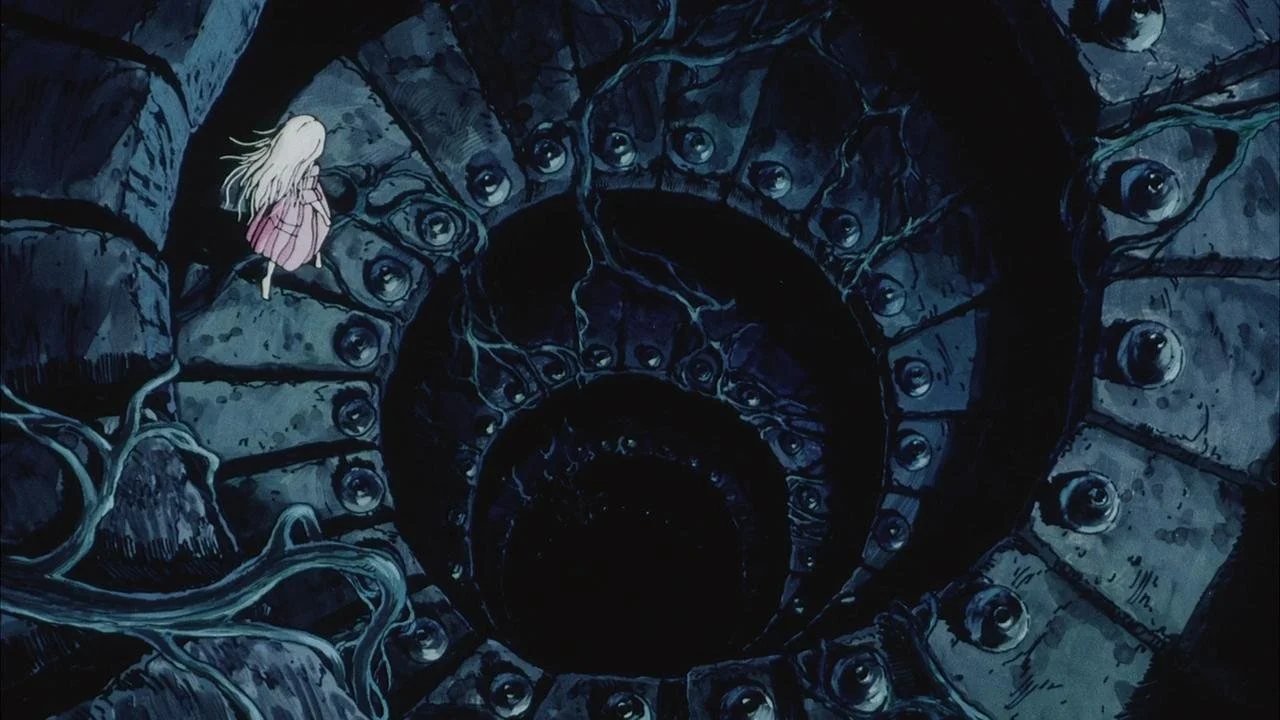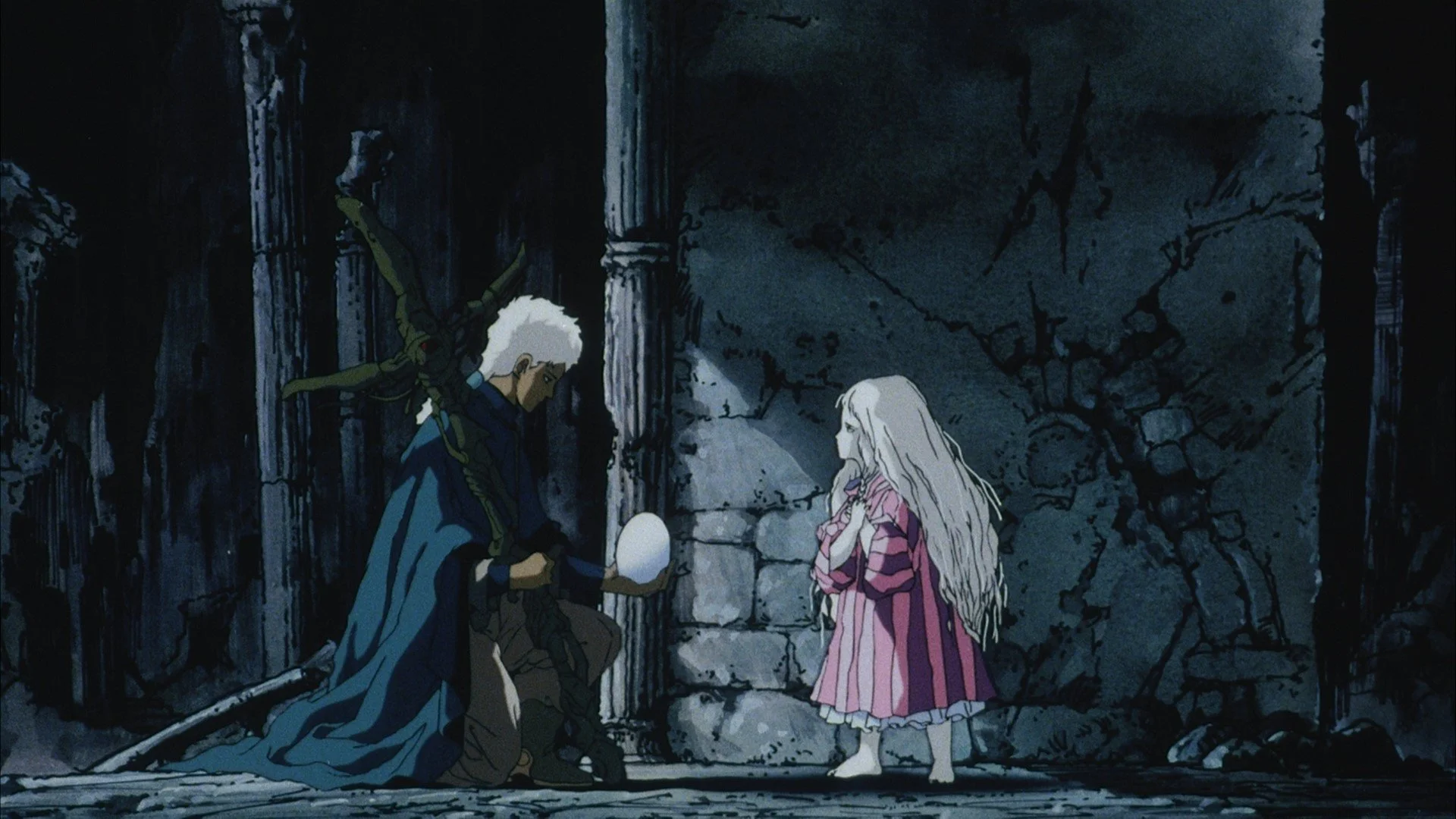FF ’25: Angel’s Egg 4K Restoration
Chances are that if anyone outside of Japan has seen Angel’s Egg before, it was under less-than-ideal circumstances. The film has been uploaded to YouTube over the years, but in horribly crushed 480p quality. The next best method has caveats of its own, bootleg Blu-Rays with manually added English subtitles sourced from a 2013 Japanese Blu-Ray. Angel’s Egg only exists in one other form in the Western world as part of an obscure Australian movie called In the Aftermath that mixes original live-action footage with animation from Angel’s Egg. Simply put, watching Angel’s Egg in the quality it deserves has been a significant challenge for decades outside of Japan. Having the opportunity to see a 4K restoration of Angel’s Egg in a movie theater, at Fantastic Fest no less, is a dream come true. Forty years after its release, Angel’s Egg has finally been properly restored by GKIDS under the supervision of director Mamoru Oshii. For the first time in North America, film geeks and cinephiles can experience this one-of-a-kind cult masterpiece.
As much as I am overjoyed by finally getting to see Angel’s Egg as intended, there’s a reason that this film almost did serious damage to Mamoru Oshii’s career and temporarily prevented him from finding work in the Japanese animation industry; Angel’s Egg is notoriously inaccessible to wider audiences because of its creative choices.
Mamoru Oshii’s work on franchises like Patlabor and Ghost in the Shell is iconic for the ways in which he balances the creeping oppression of technology and violence with contemplative sequences of reflection and introspection in worlds where the time for such moments is vanishing. Angel’s Egg is virtually identical to those ideas in the broadstrokes, but it’s missing the action and clear technological worldbuilding of those two franchises.
Angel’s Egg refuses to explain itself fully, has only two voiced characters who barely speak for most of the 71-minute-runtime, and moves at a snail’s pace. There is a wide shot in this movie that is almost static, in which one character sleeps and the other watches a fire die in real-time for several minutes. The speed at which Angel’s Egg moves is comparable to the works of Andrei Tarkovsky and Béla Tarr. This is, understandably, a tough pill to swallow for even the proudest film geeks and cinephiles across the world, regardless of the relatively short 71-minute-runtime. However, if you can stick with Angel’s Egg until the credits hit, you will be rewarded with one of the most jaw-dropping series of ending images in an animated movie.
A traditional synopsis is practically useless for Angel’s Egg. A girl (Mako Hyôdô) lives in an ark-shaped structure constructed out of the bones of long-dead beasts in an unspecified time and place. She scavenges a nearby city, comprised of Gothic architecture, while guarding an egg she believes will hatch. A young man (Jinpachi Nezu) bearing a cross-shaped staff appears in the city on a train-like machine with strange organic parts. The only other inhabitants of the city are identical figures dressed like fishermen, armed with spears and chasing the shadows of gigantic fish they can never catch. The young man keeps following the girl, looking for answers to who he is, and what is inside of the egg.
In case the phrase “ark-shaped structure” didn’t clue you in, this is a film inspired by the Bible. Angel’s Egg would make for a fascinating double-feature with Darren Aronofsky’s Noah for a number of obvious reasons, but the biggest is how both directors take influence from religion at a distance. Aronofsky was raised in a Jewish community but is not a religious man. Oshii is not a believer in Christianity, but he claimed in a 1996 interview that he’d read the Bible as far back as his student days. Each director treats the Old Testament as literature to be adapted cinematically, not as a religious doctrine that must be followed to the letter. The difference is that Angel’s Egg is not a straightforward adaptation of any story from the Old Testament the way Noah is, and it’s better off for it.
Angel’s Egg is designed for interpretation. The infrequent dialogue, mostly from the young man, suggests a wide range of possibilities for what exactly is going on in this derelict ruin of a world, but his blank expressions hint that even he may not understand what he’s saying. The girl is singularly driven to protect the egg, and has even fewer lines than the young man. This sparse plot, combined with the dreamlike slow pace, is designed to let your mind wander and ask increasingly bleak questions about how this world fell into its current state.
Angel’s Egg's lack of dialogue means it’s primarily driven by gorgeous art direction and animation, spearheaded by the legendary Yoshitaka Amano (who worked on the Vampire Hunter D OVA that was released the same year as Angel’s Egg). This is why the 4K restoration is so important – there are details in the backgrounds and animation that have been muddy or undefined for Western viewers for the past 40 years. Even the bootleg Blu-Rays sourced from the 2013 Japanese release are not as detailed as you’d hope for a film this reliant on atmosphere and mood. The degree to which this restoration is a substantial step up cannot be overstated, especially where enduring its slow pace is concerned. It’s a lot easier to sit in still moments when there’s more visual interest to study in the frame, and having a full theater screen to pore over makes that much easier to bear.
The improvements in the 4K restoration aren’t purely visual. The audio is also cleaner, though this improvement is marginal compared to the 2013 Blu-Ray release. Regardless of what version of Angel’s Egg you watch, the music from composer Yoshihiro Kanno is haunting, quickly snapping between moments of uncomfortable calm to overwhelming barrages of sound. The film’s opening where an enormous floating orb made of statues descends from the sky, hissing steam, bludgeons viewers with its soundscape, and it is far from the last time the audio will overwhelm the audience.
No matter if you’re watching this film from a horrific YouTube upload, one of the bootlegs, or the 4K restoration, Angel’s Egg’s ending is jaw-dropping in any level of visual or audio quality. The reveal is as slow as anything else in the movie, but the deliberate pacing builds to a series of static images slowly pulling back from the camera that recontextualize everything you’ve seen up to that point. This ending is not an explanation; It’s a framework in which the viewer is encouraged to meet Angel’s Egg halfway and put their own ideas into what those images mean.
It is a perfect conversation starter, a work of art destined to be discussed by those who’ve seen it for as long as it can be accessed. This is why the 4K restoration is so important, not only to make sure Angel’s Egg can be seen the way it was meant to be, but that when the restoration hits theaters later this year in November it can find an even larger audience to interpret its mysteries (and even further, once the 4K restoration is released physically at a later date).
Despite Angel’s Egg’s esoteric methods, the 71-minute runtime means that even if you do end up despising it, you won’t have taken too much of your time to realize that. My only request is if you start Angel’s Egg, you must finish it. Commit to its sludgy rhythms and jagged abstractions all the way to the end, whether that end is bitter, sweet, or both.
If you enjoyed this article, please consider becoming a patron of Hyperreal Film Journal for as low as $3 a month!




Jacob is a writer based in Austin, TX who loves giving infamous movies a chance, for better or worse. You can find him on Letterboxd at @Jacob_Ethington and on Instagram at @midwest_bummer.